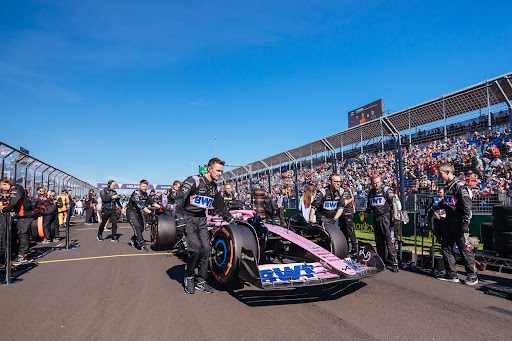Formula 1 is not just a test of speed and driver skill, it is a complex dance of strategy, teamwork, and split-second decisions that can make or break a race. The role of team strategy in F1 is critical, involving meticulous planning and real-time adjustments to outmanoeuvre competitors and optimise performance. Let’s dive deep into the various aspects of team strategy that play a pivotal role in the thrilling world of F1 racing.
Pre-Race Preparation
Before the lights go out, teams spend countless hours analysing data, weather forecasts, and the performance of their cars. Engineers and strategists craft multiple race plans, taking into account potential scenarios such as crashes, safety cars, and pit stops. This preparation is essential to ensure that the team can adapt to any situation that arises during the race.
Data Analysis
Data analysis is the backbone of pre-race preparation. Teams gather vast amounts of data from previous races, simulations, and practice sessions. This data includes lap times, tyre wear rates, fuel consumption, and telemetry data from the car’s sensors. By analysing this data, teams can identify patterns and trends that help them make informed decisions about car setup, tyre selection, and race strategy.
Weather Forecasts
Weather conditions can have a significant impact on a race. Teams closely monitor weather forecasts to anticipate changes in temperature, humidity, and the likelihood of rain. This information is crucial for determining the optimal tyre strategy and making adjustments to the car’s setup. A sudden rain shower can turn the race on its head, and being prepared for such scenarios can make all the difference.
Scenario Planning
Scenario planning involves creating multiple race plans to account for various potential situations. Teams consider factors such as crashes, safety cars, and red flags. They develop contingency plans for each scenario, ensuring that they can quickly adapt their strategy if the unexpected occurs. This level of preparation helps teams stay one step ahead of their competitors.
Pit Stop Strategy
Pit stops are one of the most vital elements of F1 strategy. The timing and execution of pit stops can dramatically affect a driver’s position in the race. Teams must decide the optimal lap for tyre changes, balancing the risk of tyre degradation against the time lost in the pits. A well-timed pit stop can catapult a driver ahead of rivals, while a poorly executed one can cost valuable positions.
Timing and Execution
The timing of pit stops is a delicate balancing act. Teams must consider factors such as tyre wear, fuel levels, and track position. Pitting too early can result in excessive tyre wear later in the race while pitting too late can lead to a loss of track position. The execution of the pit stop itself is also critical. Pit crews practice tirelessly to ensure that tyre changes are completed in a matter of seconds, minimising the time spent stationary.
Under and Overcut
The concepts of undercut and overcut are key strategies in pit stop planning. An undercut involves pitting earlier than a rival to gain an advantage by running on fresher tyres. Conversely, an overcut involves staying out longer on the track to benefit from a clear track and potentially gain positions. Teams must carefully assess the situation and choose the strategy that offers the best chance of success.
Tyre Management
Tyre selection and management are also crucial. Teams choose from different tyre compounds, each with its trade-offs between speed and durability. During the race, drivers must manage their tyres to maintain performance and avoid excessive wear. The team’s ability to read the track conditions and communicate with the driver about tyre status is essential for success.
Tyre Compounds
Pirelli, the official tyre supplier for F1, provides teams with a range of tyre compounds, from soft to hard. Soft tyres offer more grip but wear out quickly, while hard tyres are more durable but provide less performance. Teams must choose the right compound for each phase of the race, considering factors such as track temperature, surface abrasiveness, and the likelihood of rain.
Tyre Degradation
Tyre degradation is a critical factor in race strategy. As tyres wear out, their performance decreases, leading to slower lap times. Drivers must manage their tyres carefully, avoiding aggressive driving that can cause excessive wear. Teams use data from tyre sensors to monitor degradation and make informed decisions about when to pit for fresh tyres.
Real-Time Decision Making
During the race, the team’s strategists monitor data and make real-time decisions to adapt to changing circumstances. They must consider the actions of rival teams, track conditions, and the driver’s feedback. Communication between the driver and the pit wall is constant, ensuring that every decision is informed and timely.
Live Data Monitoring
Teams have access to a wealth of live data during the race, including telemetry from the car, tyre temperatures, and lap times. Strategists use this data to make real-time decisions about pit stops, tyre strategy, and fuel management. The ability to react quickly to changing conditions is a key factor in achieving a successful race result.
Driver Feedback
The driver’s feedback is invaluable in real-time decision-making. Drivers provide insights into the car’s handling, tyre performance, and track conditions. This information helps the team make adjustments to the race strategy and optimise performance. Effective communication between the driver and the pit wall is essential for making informed decisions under pressure.
The Human Element
While technology and data play significant roles, the human element of F1 strategy cannot be underestimated. The intuition and experience of team members, from the strategists to the pit crew, contribute significantly to the outcome of the race. Trust and seamless coordination within the team are fundamental to executing complex strategies under pressure.
Intuition and Experience
Experienced team members bring a wealth of knowledge and intuition to the decision-making process. They can draw on past experiences to make quick judgments in high-pressure situations. This human element adds a layer of depth to the F1 strategy that cannot be replicated by data alone.
Team Coordination
Seamless coordination within the team is essential for executing complex strategies. Pit crews, engineers, and strategists must work together like a well-oiled machine. Trust and communication are key to ensuring that everyone is on the same page and that decisions are executed flawlessly.
Conclusion
In Formula 1, a race is won by more than just the fastest car or the most skilled driver. The intricate strategy that goes into each race, from pre-race planning to real-time decision-making, is a testament to the depth and complexity of the sport. The role of team strategy in F1 is a key component of the thrilling and unpredictable nature of this high-speed competition. It’s this blend of human skill, technological innovation, and strategic brilliance that makes Formula 1 one of the most exciting sports in the world.
Written by Gareth Booth


Leave a Reply